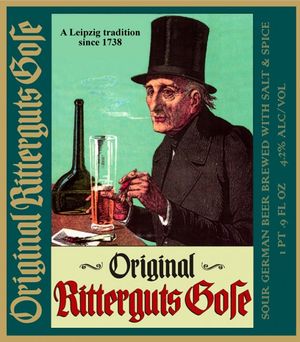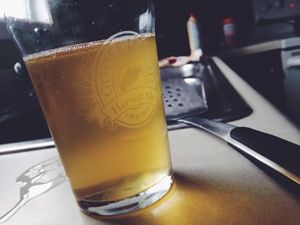Difference between revisions of "Gose"
m (updated Gose book link) |
|||
| Line 34: | Line 34: | ||
===== Fermentables ===== | ===== Fermentables ===== | ||
| + | For an 8 gallon batch: | ||
{| class="wikitable sortable" | {| class="wikitable sortable" | ||
! Malt !! Weight !! % | ! Malt !! Weight !! % | ||
Revision as of 15:44, 30 June 2019
Gose (Goes-uh) is a salty, sour, beer from Goslar, Germany that is brewed with at least 50% malted wheat (although a few historical sources say that Gose was brewed with 100% wheat [1]). Gose has a low hop bitterness and aroma and gets a lemony character from the use of coriander. The straw-like colored Gose (2-6 SRM) sits at a sessionable ABV around 3-5%, made up of mostly pilsner and wheat. Gose is usually unfiltered, so some haziness is to be expected [2].
Contents
Historical
Historical texts suggest that some versions of Gose underwent an initial spontaneous fermentation that formed a "leather like" barrier over the beer, and yeast was only pitched when the beer "was given away". A bacteria described as "Bacterium acetosum" in 1897 was identified as one of the important microbes that make Gose. This bacteria was described as an acetic acid producer, and could also be used to make vinegar. This bacteria was also hypothesized as being responsible for forming this "leather like" pellicle, although speculation includes the possibility of the presence of a SCOBY. Some sources indicate that Gose was also bottled in thin long neck bottles without a cork, and the bacteria reformed the "leather like" pellicle in the neck of the bottle that when dried out captured the CO2 in the bottle (the exact mechanism of how the "pellicle" dried out and became sturdy enough to hold carbonation is not understood). Coriander was not traditionally used in the brewing of Gose, but spruce branches were used for lautering and spiced versions used Vermouth and Cinnamon. Gose had less lactic acid than Berliner Weisse, however it was described as being more sour than Berliner Weisse. This was probably due to higher amounts of acetic acid in Gose from the spontaneous fermentation and the acetic acid producing bacteria [3][4].
Most historical Gose beers were probably brewed with 100% air dried malted wheat, although one example was reportedly brewed with 55% barley malt. Table salt was often added, and/or highly mineral water [1]. The original gravities of historical Gose seemed to change through time. In the mid 1850's, they seemed to be around 13-14°P (1.053-1.057 SG). In the early 1900's, the original gravities seemed to become smaller at around 9-10°P (1.036-1.040 SG), although some versions were still brewed with the higher starting gravities of the 1850's. Gose had a high finishing gravity with attenuation of around 60%, indicating that the beer might have been served young and with some amount of residual sweetness [5].
See also:
- Published book "Gose: Brewing a Classic German Beer for the Modern Era" by Fal Allen.
- Benedikt Koch's blog on historical research of Gose.
- Translations by Benedikt Koch of 1800's texts on how Gose was made, including bottling without corks and spontaneous fermentation on MTF.
- Speculation by Koch on the possibility of propionic acid producing bacteria in Gose on MTF.
- Gose from Goslar was probably fermented with yeast residing in spruce barrels (Benedikt Koch's blog).
- Benedikt Koch's water report of the salinity of the Gose river, speculation on where the saltiness in Gose came from, and how the Germans distributed water from the Gose river to breweries and homes in Goslar.
Video
Milk the Funk Gose Recipe
Description
The Milk The Funk Gose is an 8 gallon (8 gallons in the fermenter) recipe for a lemony, tart, and lightly salty beer that will quench any thirst on a summer's day. This recipe is an 8 gallon, no boil recipe, and is made for a system with 73% efficiency. Please adjust the recipe to fit your system.
Stats
- 1.035 OG
- 1.004 FG
- 4.0 ABV
- 2 SRM
- No hops if possible. If hops have to be used, then ~3-4 IBU from mash hops
- Mash 60min @ 145°f
Fermentables
For an 8 gallon batch:
| Malt | Weight | % |
|---|---|---|
| Floor-Malted Bohemian Wheat (DE) | 5 lbs | 50 |
| Floor-Malted Bohemian Pilsner (DE) | 5 lbs | 50 |
| Extract Version * | Weight | % |
|---|---|---|
| Briess CBW® Bavarian Wheat Dried Malt Extract (or similar) | 3 lbs | 50 |
| Briess CBW® Pilsen Wheat Dried Malt Extract (or similar) | 3 lbs | 50 |
- * Note about the extract version: Devin Bell has also used 70% wheat DME to 30% pilsner DME and 100% wheat DME with good results. Briess CBW® Bavarian Wheat DME is 65% wheat and 35% barley.
Adjunct
| Adjunct | Weight | Time |
|---|---|---|
| Salt (fleur de sel) | 0.5 oz | 0 min |
| Ground Coriander Seed | 1 oz | 0 min |
Hops
No hops if possible. Any amount of hops will prevent lactic acid production with Lactobacillus plantarum. If hops have to be used for legal reasons (for commercial breweries, for example):
| Hop | Weight | Use | Alpha Acids |
|---|---|---|---|
| Golding (UK) | 2 oz | Mash hop, or add after souring | 8 AAU |
Yeast / Bacteria
| Name | Laboratory | Product ID | Starter | Attenuation |
|---|---|---|---|---|
| Lactobacillus Blend (brevis, delbrueckii, and plantarum) * | Omega Yeast Labs | OYL-605 | None | N/A |
| Brett Sacc Trois | White Labs | WLP644 | 1 vial in 500 mL DME starter for 5-8 gallons | 87.5 |
- * If OYL-605 is not available, substitute it with a probiotic culture such as Goodbelly Mango or Swansons Plantarum. See Culturing From Probiotics [6].
Steps
- 1-2 days before brewing make a 1 liter starter of 1.040 wort, and add your vial of WLP644. Let it sit at room temperature until use. Also make 1 liter of 1.040 wort, and pour OYL-605 into the starter. Incubate 24-48 hours at room temperature to increase the cell count.
- Mash in at 145°f for 60 minutes; if hops have to be used, make sure to add the hops to the mash.
- Sparge as normal.
- Bring the wort to a boil, add salt and coriander, and then turn the heat off (no need to boil for more than a couple of minutes).
- Adjust PH ~4.2 to limit growth Clostridium butyricum and other potential off-flavor bacteria. Not necessary, but this is a best practice suggestion. See How to Pre-Acidify for instructions.
- Chill the wort down to 95°f, and transfer to a CO2 purged carboy or keg. Add the 1 liter of OYL-605 Lactobacillus Blend starter. Allow it to sour for 24 hours. No external heating is required.
- After the souring phase, chill the soured wort down to ~70°F and pitch WLP644 Trois (boiling to kill the Lactobacillus before adding the WLP644 Trois is optional; see kettle souring). You can aerate if you feel necessary. After 2 weeks a stable gravity should be reached.
- Rack or transfer off as normal to bottles or a keg.
See Also
Additional Articles on MTF Wiki
External Resources
- Translations by Benedikt Koch of 1800's texts on how Gose was made, including bottling without corks and spontaneous fermentation on MTF.
- Gose - Shutup About Barclay Perkins blog.
- The Sixth German Gose - Lars Garshol's blog.
- Gose - German Beer Institute.
- Going For Gose - Michael Jackson, The Beer Hunter.
- Sour Leipziger Gose Recipe - The Mad Fermentationist.
- Gose, BYO Magazine, 2011 - Justin Burnsed.
- The Summer of Gose, Ale of the Riverwards - Ed Coffey.
- "Old German Beer Styles," by Ron Pattinson (contains a few obscure sour styles).
- MTF Thread on the qualities of different types of salt when used in Gose.
- Brewing Gose with Seawater on Third Leap blog. See also this associated MTF post.
- Gordon Strong's article on which category to enter fruited "Berliner Weisse", "lambic", and sour beers into BJCP competitions (applies to gose).
References
- ↑ 1.0 1.1 Koch, Benedikt. "Gose Malt Bill". Wilder-wald.com blog. 02/17/2017. Retrieved 02/26/2017.
- ↑ Wikipedia. Gose. Retrieved 4/1/2015.
- ↑ Koch, Benedikt. "Gosslarsche Gose". Wilder-wald.com blog. 02/15/2017. Retrieved 02/26/2017.
- ↑ Translations by Benedikt Koch of 1800's texts on how Gose was made, including bottling without corks and spontaneous fermentation on MTF, with speculative comments by Richard Preiss.01/17/2017.
- ↑ Koch, Benedikt. "Gose Original Gravity". Wilder-wald.com blog. 02/17/2017. Retrieved 02/26/2017.
- ↑ MTF conversation about substituting OYL-605 if it is not available. 04/12/2016.


